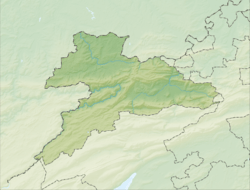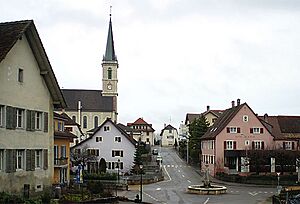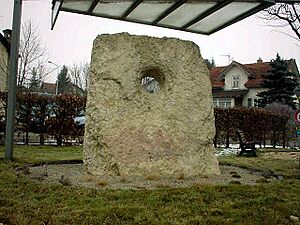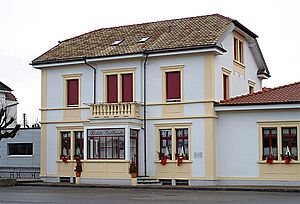Courgenay facts for kids
Quick facts for kids
Courgenay
|
||
|---|---|---|
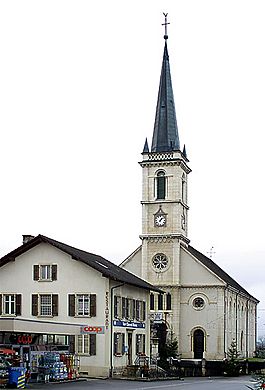
Courgenay village church
|
||
|
||
| Country | Switzerland | |
| Canton | Jura | |
| District | Porrentruy | |
| Area | ||
| • Total | 18.44 km2 (7.12 sq mi) | |
| Elevation | 488 m (1,601 ft) | |
| Population
(Dec 2020 )
|
||
| • Total | 2,400 | |
| • Density | 130.2/km2 (337/sq mi) | |
| Postal code |
2950
|
|
| Surrounded by | Porrentruy, Alle, Cornol, Montmelon, Seleute, Ocourt , Fontenais | |
Courgenay is a small town, also called a municipality, located in the Jura area of Switzerland. It is part of the Porrentruy district.
Contents
History of Courgenay
Courgenay was first mentioned in official records way back in 1139. At that time, its name was spelled Corgennart.
Exploring Courgenay's Geography
Courgenay covers an area of about 18.42 square kilometers (7.11 square miles). A large part of this land, almost half (48.3%), is used for farming. This includes fields for crops and areas for animals to graze.
Another big part, about 42.1%, is covered by forests. These forests are important for the environment and for wildlife.
About 9.3% of the land is built up with buildings and roads. This is where people live and work. A tiny bit of land (0.1%) is rivers or lakes. The rest is land that isn't used for farming or building.
Courgenay includes the main village of Courgenay. It also has a smaller settlement called Courtemautruy, which is a hamlet. A hamlet is a very small village. Two other villages, Courtemblin and Courtari, used to be here. However, they were abandoned around the time of the Thirty Years War.
Courgenay's Coat of Arms
The official symbol of Courgenay is its coat of arms. It shows a red goose standing on green hills. Above the goose, there are three red stars. This design is called a blazon.
Who Lives in Courgenay? (Demographics)
Courgenay has a population of about 2,118 people. Around 9.4% of the people living here are from other countries. Over the past ten years, the number of people in Courgenay has grown by about 2%.
Most people in Courgenay speak French. About 92.7% of the population uses French as their main language. The second most common language is German, spoken by 3.7% of residents. A smaller number, 1.3%, speak Italian.
In Courgenay, the population is almost evenly split between males and females. About 49.8% are male and 50.2% are female. Many people (37.1%) were born in Courgenay itself. Others were born in the same canton (34.6%) or elsewhere in Switzerland (10.9%). About 14.1% of residents were born outside Switzerland.
Young people, aged 0 to 19, make up about 24.2% of the population. Adults (20 to 64 years old) are 57.1%. Seniors (over 64 years old) make up 18.6%.
Most households in Courgenay have about 2.4 people living in them. There are also many single-person households.
The chart below shows how Courgenay's population has changed over many years:

Important Heritage Sites
Courgenay is home to an important historical site called Pierre-Percée. This is a neolithic dolmen. A dolmen is a type of ancient stone tomb or monument. It was built by people from the Stone Age. This site is so important that it's listed as a Swiss heritage site of national significance.
Courgenay's Economy and Jobs
In 2010, the unemployment rate in Courgenay was 6.6%. This means that 6.6% of people looking for work could not find a job.
Many people in Courgenay work in different types of jobs:
- Primary sector: This includes jobs like farming. About 83 people work in this area.
- Secondary sector: This includes jobs in manufacturing (making things) and construction (building things). About 465 people work here.
- Tertiary sector: This includes jobs in services, like shops, hotels, transport, and healthcare. About 285 people work in this sector.
Overall, about 981 residents in Courgenay have jobs. Around 40.5% of these workers are female.
Many people who live in Courgenay travel to other towns for work. Also, some people travel into Courgenay for their jobs. About 25.7% of the people who come to work in Courgenay are from outside Switzerland. Most people (65%) use a private car to get to work. About 10.7% use public transport, like trains or buses.
Religion in Courgenay
Most people in Courgenay are Roman Catholic, making up about 72.1% of the population. Another group, about 15.5%, belong to the Swiss Reformed Church.
There are also smaller numbers of people who follow other Christian churches, Islam, or Buddhism. Some people (4.66%) do not belong to any church or are agnostic or atheist.
Getting Around: Transport
Courgenay is connected by train. It is located on the Delémont–Delle line. You can catch trains at the Courgenay railway station.
Learning in Courgenay: Education
In Courgenay, many people have completed higher levels of education. About 32.4% have finished non-mandatory upper secondary education. This is like high school. About 7.9% have gone on to even higher education, like university.
The school system in the Canton of Jura works like this:
- Two years of non-required Kindergarten.
- Six years of Primary school.
- Three years of required lower Secondary school. Students are grouped by their abilities.
- After lower Secondary, students can choose to go to a three or four-year upper Secondary school. They can also go to a special Tertiary school or start an apprenticeship. An apprenticeship is when you learn a job by working with an experienced person.
During the 2009-2010 school year, Courgenay had 198 students in 11 classes. There were 49 students in kindergarten and 149 students in primary school. Students from Courgenay go to secondary school in other towns because there are only nine secondary schools in the whole canton.
Famous People from Courgenay
- Gilberte Montavon (1896–1957): A famous person from Courgenay. A movie called Gilberte de Courgenay was made about her life.
See also
 In Spanish: Courgenay (Jura) para niños
In Spanish: Courgenay (Jura) para niños




